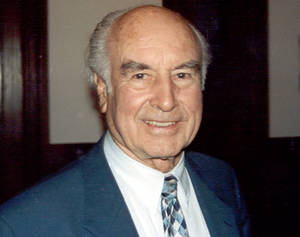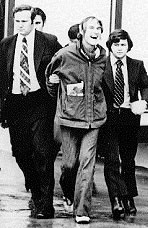"If you're going to San Francisco be sure to wear some flowers in your hair," sang  Scott McKenzie in 1967 as the hippy movement gathered momentum.
Scott McKenzie in 1967 as the hippy movement gathered momentum.
LSD and the hippy movement
In the 1960's the hippy movement had a profound effect on western culture, influencing thought, music, art and clothing. Thousands of young Americans flocked to the Haight district of San Francisco at this time to embrace an alternative lifestyle. Although the movement was based in San Francisco, its effects were felt around the world and culminated in the Summer of Love in 1967 and music festivals such as Woodstock in 1969. Drugs were important for the hippies and LSD ("acid" or lysergic acid diethylamide to give it the proper chemical name) was one of these. LSD in particular was attractive owing to its ability to induce altered states of consciousness with changes to perception; this is the so-called psychedelic experience.
But, in spite of the hippies craving "all things natural", LSD was actually discovered by an industrial chemist, Albert Hofmann, who died in 2008 aged 102. Hoffman's work undoubtedly heralded a new era of psychedelia, ultimately influencing music, including the world-famous Beatles, hippy culture and even academia: the infamous slogan of Harvard Professor and writer Timothy Leary was "turn on, tune in, drop out". But how did this come about?
Ergot
For years people had known that the fungus, Claviceps purpurea, which grows on rye and is more commonly known as ergot, contained a number of chemicals with powerful physiological effects.  The affliction described in the Middle Ages and termed "holy fire" or "St Anthony's Fire" is thought to have been caused by eating bread made from rye flour contaminated with ergot. Sufferers reported burning sensations in their limbs, numbness, fits and even gangrene. Ergot preparations have also been used by obstetricians for many years to "quicken labour". Clearly ergot contained substances with powerful effects on the human body, which piqued the interests of the pharmaceutical industry.
The affliction described in the Middle Ages and termed "holy fire" or "St Anthony's Fire" is thought to have been caused by eating bread made from rye flour contaminated with ergot. Sufferers reported burning sensations in their limbs, numbness, fits and even gangrene. Ergot preparations have also been used by obstetricians for many years to "quicken labour". Clearly ergot contained substances with powerful effects on the human body, which piqued the interests of the pharmaceutical industry.
Albert Hoffman and the discovery of LSD
Indeed, in the early and mid 20th century, Sandoz, a drug company based in Basel, had the bright idea that these substances in ergot might provide new medicines, so they set out to identify the different agents it contained. A number of pure chemicals were soon isolated including ergonovine, the active compound with effects on childbirth. Next the company began to explore the possibility of producing derivatives of the ergot compounds and Albert Hofmann was one of the chemists involved in this work. His famous discovery occurred in 1943 when he synthesised the molecule we now call LSD. He must have got some of the chemical on his hands as the following day he wrote to his boss:
"Last Friday, April 16th 1943, I was forced to interrupt my work in the laboratory in the middle of the afternoon and proceed home being affected by a remarkable restlessness combined with a slight dizziness. At home I lay down and sank into a not -unpleasant intoxicated-like condition, characterised by an extremely stimulated imagination. In a dream like state with eyes closed, I perceived an uninterrupted stream of fantastic pictures, extraordinary shapes with intense kaleidoscopic display of colours. After some two hours this condition faded away."
Three days later he tested the idea that the chemical he had made had caused these strange sensations. He took 0.25 mg of LSD under more controlled conditions and again experienced the powerful psychedelic effects of the drug, although more strongly. He rode home on his bike under the influence of the drug and April 19th 1943 is now referred to as "Bicycle Day" in the psychedelic counter-culture.
How LSD has been used
These were the first recorded "LSD trips" and Hofmann went on to try LSD many times. He believed that the drug was an important tool for exploring human consciousness.  It was initially tried in various medical conditions and for example the actor Cary Grant took it during psychotherapy. In the 1960's LSD was espoused by the hippy movement. Many well known people used it and Timothy Leary did much to publicise its use, suggesting it increased awareness and perception. It was also tried as a truth drug by the CIA but its effects were found to be too unpredictable. The widespread use of LSD, however, lead to some people having "bad trips", there were some deaths and the drug was eventually banned.
It was initially tried in various medical conditions and for example the actor Cary Grant took it during psychotherapy. In the 1960's LSD was espoused by the hippy movement. Many well known people used it and Timothy Leary did much to publicise its use, suggesting it increased awareness and perception. It was also tried as a truth drug by the CIA but its effects were found to be too unpredictable. The widespread use of LSD, however, lead to some people having "bad trips", there were some deaths and the drug was eventually banned.
Interestingly, compounds related to LSD are found in another plant, the morning glory species, Rivea corymbosa. This plant formed the basis of the Aztec magical potion, ololiuqui, used in divinatory activities and sacrificial ceremonies. Hofmann showed that the seeds of this plant contained lysergic acid amide, less potent than LSD but closely related.
So, LSD is a very interesting drug that might be of use in understanding some basic aspects of humanity but it has caused many problems. A tension arose between the apparent therapeutic use of the drug and its recreational use/abuse. This tension between use and abuse of a drug is emerging nowadays for some of the "smart drugs" such as modafinil. These drugs may have an important place medically but their recreational or non-therapeutic use has caused concern. Society will need to consider the ethical issues involved very carefully.
Mechanism of action of LSD
So how does LSD work? It takes advantage  of some normal processes involved in the function of our brains. Brain function depends in part on the release and detection of certain chemicals termed neurotransmitters. Detection of these chemicals takes place at specific protein sites called receptors, which recognise and react to the neurotransmitter. In the case of LSD some of its important sites are receptors for the neurotransmitter serotonin, which is found in the brain and in other parts of the body where it is responsible for controlling behaviour, mood, sleep, appetite and blood flow; so it is not a surprise that LSD has such diverse effects.
of some normal processes involved in the function of our brains. Brain function depends in part on the release and detection of certain chemicals termed neurotransmitters. Detection of these chemicals takes place at specific protein sites called receptors, which recognise and react to the neurotransmitter. In the case of LSD some of its important sites are receptors for the neurotransmitter serotonin, which is found in the brain and in other parts of the body where it is responsible for controlling behaviour, mood, sleep, appetite and blood flow; so it is not a surprise that LSD has such diverse effects.
LSD is only one drug derived from the work started in Basel on ergot, but it has had a huge impact over the years. Some of the other drugs related to ergot and currently available are ergometrine (formerly ergonovine), which is used for suppressing blood loss after childbirth, ergotamine, for migraine, hydergine (a mixture of compounds used to treat dementia although its efficacy is not well established in controlled trials) and lisuride, pergolide and bromocriptine which are used to control the symptoms of Parkinson's disease.
So, surprising as it sounds, just because something's mouldy doesn't necessarily mean it's bad!
- Previous What is the Weirdest Experiment Ever?
- Next More microfossils










Comments
Add a comment